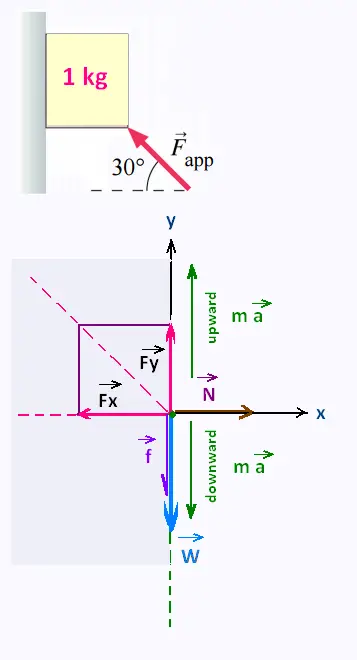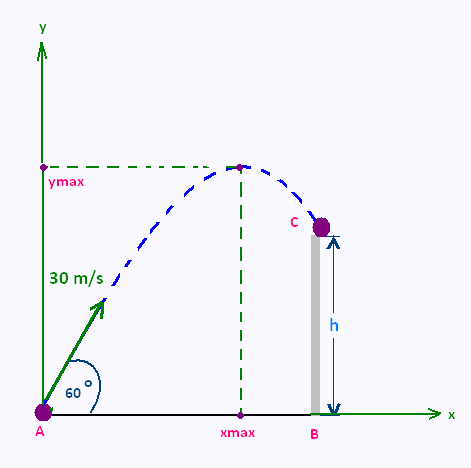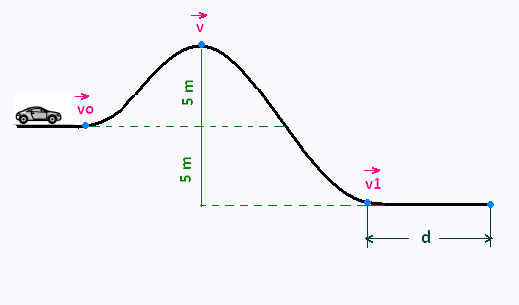Physics
NYA Mechanics
Examination
Part I
Exercise 1
A 1 kg box slides on a vertical wall while being pushed at an angle of 30� as shown in the
figure below. The coefficient of kinetic friction (�k) between the box and the wall is 0.20.
(a) Draw free-body diagrams for both upward and downward sliding possibilities.
(b) If the applied force, Fapp has a magnitude of 12N, determine whether the box is sliding
up or down the wall. Find the magnitude of the acceleration for this Fapp.
(c) Suppose now that the box is sliding downward at constant speed. In this case, find the
required magnitude of the applied force oriented as in the figure to produce these
dynamics
a)

b)
Along the x axis: - Fx + N = 0
Along the y axis: - W - ƒ + Fy = m a
We have then:
Fx = N = F cos 30o = F √3/2 = 12 √3/2
= 6 √3
N = 6√3 Newtons
ƒ = μN = 0.20 x 6 √3 = 1.2 √3
ƒ = 1.2 √3 = 2.08 Newtons
m a = Fy - W - ƒ
W = mg = 1 x 9.8 = 9.8 Newtons.
Fy = F sin 30o = F/2 = 6 Newtons.
a = (Fy - W - ƒ )/m = (6 - 9.8 - 2.08)/1 =
- 5.88 m/s2.
a = - 5.88 m/s2
The box is moving downward.
c)
constant speed gives a = 0. So
Fy - W - ƒ ≥ 0
At the limit:
Fy = W + ƒ = 9.8 + 2.08 = 11.88
F = 2 x Fy = 2 x 11.88 = 23.76
F = 23.76 Newtons.
Exercise 2

2. A ball is thrown toward a cliff of height h with a speed of 30 m/s and an angle of 60 degrees above the horizontal. It lands on the edge of the cliff 4.0 s later.
(a) How high is the cliff?
(b) What was the maximum height reached by the ball?
(c) What is the ball�s impact velocity?
a)
Along the x-axis:
x = vo cos 60o t = (vo/2) t
t = 2 x/vo
Along the y-axis:
y = vo sin 60o t - (1/2) g t2
The equation of the motion is:
y = vo (√3/2) ( 2 x/vo) - (1/2) g (2 x/vo)2
y = x (√3) - 2 g (x/vo)2
t = 4.0 s
x = (vo/2) t = (30/2) 4.0 = 60 m
h = 60 (√3) - 2 g (60/vo)2 =
25.52
h = 25.52
b)
y'= dy/dx = √3 - (4 g/ vo2) x = 0
√3 = (4 g/ vo2) xmax
xmax = (vo2/4g) √3 = (302/4 x 9.8) √3
= 39.77 m
ymax = xmax (√3) - 2 g (xmax/vo)2 =
39.77 √3 - 2 x 9.8 x (39.77/30)2
37.25 m
ymax = 39.77 m
c) impact velocity:
(1/2) mv2 - 0 = m g ( 39.77 - 25.52 )
v2 = 2 g ( 39.77 - 25.52 ) = 279.3
16.71 m/s
impact velocity = 16.71 m/s
Exercise 3

a)
(1/2) mvo2 = (1/2) mv2 + m g h
v2 = vo2 - 2 g h
v2 = 302 - 2 x 9.8 x 5
v2 = 302 - 2 x 9.8 x 5 =
802
v = 28.32 m/s
v = 28.32 m/s
b)
(1/2) mv12 = (1/2) mv2 + m g h
v12 = v2 + 2 g h
= 28.322 + 2 x 9.8 x 10 = 998
v1 = 31.60 m/s
v1 = 31.60 m/s
c)
v21 - 02 = 2 a d
d = v12/2 a
ma = ƒ = μ m g
a = μ g
d = v12/2μg
d = 31.602/2 x 0.3 x 9.8 =
169.73 m
d = 69.73 m
|